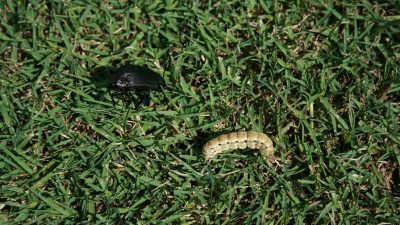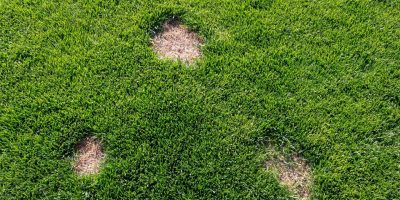Pests And Disease
A healthy lawn is a beautiful asset to any outdoor space. However, pests and diseases pose risks that can impact its health and appearance. Pests like grubs, chinch bugs, ants, and sod webworms can damage grass, while diseases caused by fungi and bacteria lead to discoloration and thinning.
To maintain a vibrant and thriving lawn, effective pest and disease management is essential. In this guide, we will explore common lawn pests, diseases, and integrated management techniques to help you protect and nurture your lawn. Let's get started!
Lawn Pests
Your lawn's appearance can be greatly affected by a variety of pests, some of which have the potential to completely destroy it. Pests like grubs, ants, sod webworms, and others can wreak havoc on your turf, leaving behind unsightly patches and compromising the health of your lawn.
These pests can chew through grass blades, disrupt root systems, and create areas of dead or dying grass. To maintain a vibrant and thriving lawn, it's crucial to be proactive in preventing and managing these common pests.

- Identify the Pest: Properly identify the pest affecting your lawn. Different pests require different treatments, so accurate identification is essential.
- Maintain Good Lawn Health: A healthy lawn is more resistant to pest infestations. Follow good lawn care practices such as regular mowing, proper watering, and appropriate fertilization to promote strong and vigorous grass growth.
- Remove Excess Debris: Clear away any excess debris, such as fallen leaves or grass clippings, as these can provide breeding grounds for pests.
- Practise Proper Watering: Water your lawn deeply and infrequently to encourage deep root growth. This helps make the grass more resilient and less attractive to pests.
- Adjust Mowing Height: Set your mower at the appropriate height for your grass type. Cutting the grass too short weakens it, making it more susceptible to pests. Avoid removing more than one-third of the grass blade in a single mowing.
- Use Beneficial Insects: Introduce beneficial insects, such as ladybugs and lacewings, which feed on common pests like aphids and mites. They can help naturally control pest populations.
- Natural Pest Control Methods: Utilize natural pest control methods like neem oil, insecticidal soaps, or horticultural oils. These eco-friendly options target pests while minimizing harm to beneficial organisms and the environment.
- Chemical Treatments: If pest populations become overwhelming and natural methods are insufficient, consider targeted and judicious use of pesticides. Always follow the instructions on the label and apply pesticides only when necessary.
- Regular Monitoring: Keep a close eye on your lawn, regularly inspecting for signs of pests. Early detection allows for timely intervention and helps prevent further damage.
- Seek Professional Help: If you’re unsure about pest identification or need assistance with treatment, consult with a professional lawn care service. They can provide expert advice and targeted solutions based on your specific pest issues.
Lawn Disease
Lawn diseases can be a bit trickier to identify compared to pests since there isn't a direct bug or insect you can spot. Instead, lawn diseases can manifest in various forms such as rust, brown patch, and powdery mildew. These diseases can cause discoloration, thinning, and overall decline in the health of your lawn. Identifying and addressing these diseases promptly is crucial to prevent further damage and maintain a lush and vibrant lawn.

- Choose Disease-Resistant Grass Varieties: When establishing or renovating your lawn, select grass varieties that are known to be resistant to common diseases in your region. Consult with local experts or nurseries for recommendations.
- Improve Air Circulation: Ensure adequate air circulation by avoiding overcrowding and overgrowth of grass. Regularly prune trees and shrubs to allow proper air movement and sunlight penetration to the lawn.
- Practice Proper Watering: Water your lawn deeply and infrequently, preferably in the early morning. Avoid overwatering, as it creates a favorable environment for disease development. Watering deeply encourages deep root growth and makes the grass more resilient to diseases.
- Avoid Excessive Fertilization: Over-fertilization can lead to excessive growth and weaken the grass, making it more susceptible to diseases. Follow recommended fertilization practices and avoid applying more fertilizer than necessary.
- Mow Properly: Set your mower blades at the appropriate height for your grass type and avoid cutting too short. Taller grass shades the soil, reduces weed growth, and promotes healthier grass, which is more resistant to diseases.
- Practice Proper Thatch Management: Thatch build-up provides a breeding ground for diseases. Regularly dethatch or aerate your lawn to prevent excessive thatch accumulation.
- Implement Good Lawn Maintenance Practices: Maintain a regular lawn care routine, including regular mowing, proper fertilization, and weed control. A healthy and well-maintained lawn is less susceptible to diseases.
- Monitor and Identify Early Signs: Regularly inspect your lawn for any signs of diseases, such as discoloration, patchy areas, or unusual growth patterns. Early detection allows for timely intervention and increases the chances of successful treatment.
- Apply Fungicides (If Necessary): In severe cases or when preventive measures have not been effective, you may need to apply fungicides. Choose a fungicide specific to the disease affecting your lawn, and carefully follow the instructions for application.
- Seek Professional Help: If you’re unsure about disease identification or need guidance in treating lawn diseases, consult with a professional lawn care service or local extension office. They can provide expert advice and recommend appropriate treatments based on your specific lawn conditions.
Remember, prevention is key when it comes to lawn diseases. By implementing proper lawn care practices and being vigilant in monitoring your lawn's health, you can minimize the risk of diseases and enjoy a lush and disease-free lawn.
While many lawn care and pest management tasks can be handled on your own, there may be instances where seeking professional assistance becomes necessary. Here are some considerations when hiring a professional for pest or disease management:
- Research local lawn care services or pest control companies and check their reputation.
- Look for companies with experience in handling the specific pests or diseases affecting your lawn.
- Read reviews or seek recommendations from friends, neighbours, or online communities.
2. Consultation and Inspection:
- Schedule a consultation or inspection with the selected professionals.
- Communicate your concerns and provide details about the issues you’re experiencing.
- Ask for their recommended treatment approach and inquire about the products or methods they intend to use.
- Request a written estimate that outlines the services and associated costs.
3. Communication and Transparency:
- Establish clear communication channels with the professionals you hire.
- Ask for regular updates on the progress of the treatments and the effectiveness of the solutions applied.
- Be open to discussing any concerns or questions you may have.
- Ensure transparency regarding the chemicals or products used and their potential impact on the environment or household members.
4. Understanding Treatment Recommendations:
- Request a clear explanation of the recommended treatments and their purpose.
- Understand the timing and frequency of the treatments required.
- Inquire about any necessary follow-up actions or maintenance practices to ensure long-term effectiveness.
Summary
Maintaining a healthy lawn free from pests and diseases requires proactive measures and a well-rounded approach. By implementing Integrated Pest Management (IPM) practices, you can effectively manage these issues while minimizing the impact on the environment. Additionally, hiring professional help when needed can provide expertise and assistance in dealing with complex or severe infestations.
Remember, a healthy lawn starts with proper care, regular monitoring, and early intervention. Embrace preventive measures, such as cultural practices and organic solutions, to create a resilient lawn that can resist pests and diseases. With a little effort and knowledge, you can enjoy a beautiful, thriving lawn that enhances the overall appeal of your property.
If you have any further questions or need additional guidance, feel free to reach out to us or consult with local lawn care professionals.